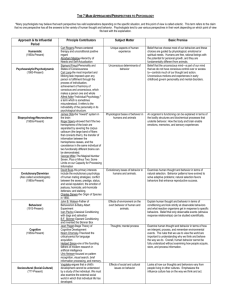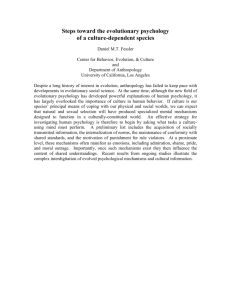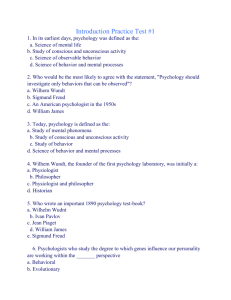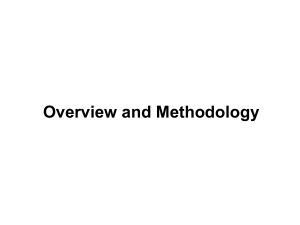Introspection: Wilhelm Wundt set up first psychology lab where he
advertisement
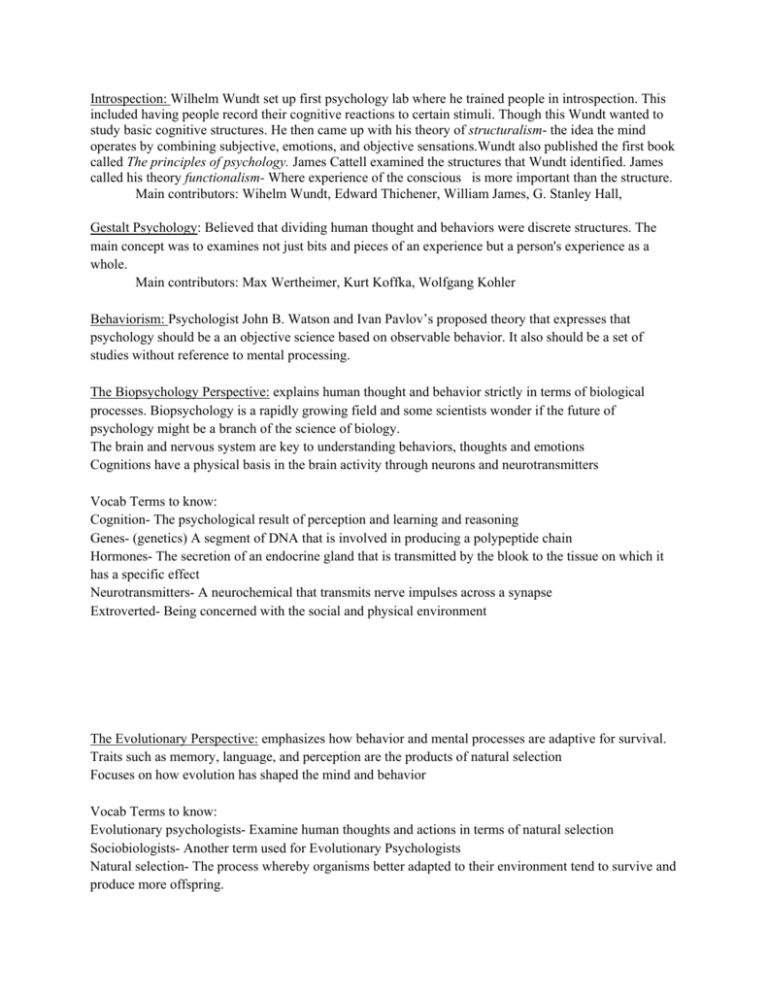
Introspection: Wilhelm Wundt set up first psychology lab where he trained people in introspection. This included having people record their cognitive reactions to certain stimuli. Though this Wundt wanted to study basic cognitive structures. He then came up with his theory of structuralism- the idea the mind operates by combining subjective, emotions, and objective sensations.Wundt also published the first book called The principles of psychology. James Cattell examined the structures that Wundt identified. James called his theory functionalism- Where experience of the conscious is more important than the structure. Main contributors: Wihelm Wundt, Edward Thichener, William James, G. Stanley Hall, Gestalt Psychology: Believed that dividing human thought and behaviors were discrete structures. The main concept was to examines not just bits and pieces of an experience but a person's experience as a whole. Main contributors: Max Wertheimer, Kurt Koffka, Wolfgang Kohler Behaviorism: Psychologist John B. Watson and Ivan Pavlov’s proposed theory that expresses that psychology should be a an objective science based on observable behavior. It also should be a set of studies without reference to mental processing. The Biopsychology Perspective: explains human thought and behavior strictly in terms of biological processes. Biopsychology is a rapidly growing field and some scientists wonder if the future of psychology might be a branch of the science of biology. The brain and nervous system are key to understanding behaviors, thoughts and emotions Cognitions have a physical basis in the brain activity through neurons and neurotransmitters Vocab Terms to know: Cognition- The psychological result of perception and learning and reasoning Genes- (genetics) A segment of DNA that is involved in producing a polypeptide chain Hormones- The secretion of an endocrine gland that is transmitted by the blook to the tissue on which it has a specific effect Neurotransmitters- A neurochemical that transmits nerve impulses across a synapse Extroverted- Being concerned with the social and physical environment The Evolutionary Perspective: emphasizes how behavior and mental processes are adaptive for survival. Traits such as memory, language, and perception are the products of natural selection Focuses on how evolution has shaped the mind and behavior Vocab Terms to know: Evolutionary psychologists- Examine human thoughts and actions in terms of natural selection Sociobiologists- Another term used for Evolutionary Psychologists Natural selection- The process whereby organisms better adapted to their environment tend to survive and produce more offspring. Important People Charles Darwin - Created a Theory of Evolution, that mutations will occur over time with genetic codes that will help aid in survival (Natural Selection) John Tooby- Helped pioneer the field of evolutionary psychology with his wife Leda Cosmides. Leda Cosmides- Along with her husband John Tooby, they co founded the Center of Evolutionary Psychology David Buss- Primary topics of his research were mating strategies, conflict between sexes, status, social reputation, and more all approached from an evolutionary perspective Psychoanalytic Perspective: - The method of psychological therapy originated by Sigmund Freud in which free association, dream interpretation, and analysis of resistance and transference are used to explore repressed or unconscious impulses, anxieties, and internal conflicts, in order to free psychic energy for mature love and work. -Sigmund Freud Free association = a method of exploring the unconscious in which the person relaxes and says whatever comes to mind no matter how trivial or embarrassing -Defense Mechanisms: o Repression o Regression o Reaction formation o Projection o Rationalization o Displacement o Denial -The mind is separated into: o Unconscious (contains id and part of superego) o Preconscious (outside awareness but accessible) o Conscious (contains the ego and part of the superego) § Id: unconscious psychic energy that strives to satisfy basic drives and operates on the pleasure principle § Ego: operates on reality principle and seeks to gratify the id in a realistic way (contains partly conscious perceptions thoughts, judgments and memories § Superego (develops as through maturation): the voice of our conscience that considers the real and ideal while focusing on how we should behave -Personality development = psychosexual stages o Oral (0-18 months) o Anal (18 mo.-3 years) o Phallic (3-6 yrs) o Latency (6-puberty) o Genital (puberty on) -Carl Jung: Neo-Freudian who put less emphasis on social factors but agreed that the unconscious has a powerful influence ● Collective Unconscious: proposed that there is a common reservoir of images that come from our universal experience -Alfred Adler: believed childhood social, rather than sexual, tensions result in personality formation ● inferiority complex: behavior is driven efforts to overcome childhood feelings of inferiorty Humanistic Perspective: The approach to psychology that emphasizes feelings and emotions and the better understanding of the self in terms of observation of oneself and one's relations with others. o Stresses individual choice and free will § Our behaviors are mostly chosen and guided by our own physiological, emotional or spiritual needs o Contrasts with deterministic behaviorists (all behaviors are caused by previous conditioning) o Personality is defined by one’s self-concept § Positive self-concept= positive actions and perceptions of the world § Negative = fall short of ideal self and feel dissatisfied and unhappyl Abraham Maslow o Proposed we are motivated by a hierarchy of needs with the ultimate goal of self-actualization (fulfilling our potential) and self-transcendence (find meaning, purpose and communion beyond self) Carl Rogers (person-centered perspective) o People are basically good with self-actualizing tendencies and in a growth promoting climate they are primed for growth and fulfillment o Three conditions to a growth-promoting climate (esp. in therapy): § Genuineness – being open with feelings, dropping facades, and being transparent and self-disclosing § Acceptance – offering unconditional positive regard § Empathy – sharing and mirroring feelings in reflecting meanings Research and Methods: Behavioral perspectives -This approach to psychology emphasizes the scientific study of observable behavior and what can be controlled by the patient, rather studying the unobservable consciousness that isn’t able to be controlled. This approach uses reward and punishment to decrease and increase certain or desired behaviors. Studies have shown that reward works better to strengthen desired behaviors rather than using punishment to decrease undesired behaviors. - Behavioral Psychologists say that the personality and behavior can be learned by observing others and seeing which behaviors are rewarded and punished. In turn this will create the behavior of others Major contributors: Ivan Pavlov, John B. Watson, B.F. Skinner, Albert Bandura Cognitive Perspective ● This perspective is almost a tie off of behavioral perspectives and they almost work together. The cognitive psychologists thought that behavior couldn’t be described and learned just off of observation. Behavior is also developed with the mind. The mind is a major roles in the processing and responses to the environmental information. ● Mainly focuses on the internal mental processes such as information processing and the storage and retrieval of memories. Major contributors: Alfred Binet, Lawrence Kohlberg, Robert Sternberg, Jean Piaget Social Perspective ● ● Humans behavior and personality are determined and influenced greatly by presence of others and their power. Social Psychologists study many factors that the presence of others may change like the nature of love, prejudice, aggressiveness, obedience, and social conformity. Many of the main factors that develop the behavior of other in the social perspective is their social interaction, socialization, gender, race, ethnicity, and cross-cultural differences. Major contributors: Erving Goffman, Lev Vygotsky Inferential Statistics: The use of current information regarding a sample of subjects to make assumptions about the population as a whole and what might happen in the future. Animal and Human Research ● Many people study animals and test on animals because they think they are fascinating.They want to see how different species differentiate in thinking, learning, and behaving. ● This has brought many advantages to us because it has helped create many medicines for deadly and common diseases. Critical thinking: The process of assessing claims and making judgments on the basis of well-supported evidence. Methods of research: Naturalistic Observation: The process of watching without interfering as behavior occurs in the natural environment. (Ex. Jane Goodall with the apes) ■Valuable when more intrusive measures might alter behavior ■Can be distorted when people know they are being watched ■Describes behavior but doesn’t answer the “why” in psychology Direct Observation: Observing behavior under controlled conditions in an experimental or laboratory settings. (Ex.Prison experiment) ● Unnatural environment may change behavior ● Observations may be biased Case Study: Intensive examinations of behavior/mental process in a particular individual, group, situation- great depth of information. (Ex. many of freud's cases) ● Useful when studying something new, complex, or rare ● Only includes information researcher find relevant (can be biased) ● May not be representative of general population Survey: Use of questionnaires or interviews to ask about behavior, attitudes, beliefs, opinions, intentions. ● Provides a wide-angle view of large groups ● Validity depends of wording and clarity ● Random sample usually best ● People may be reluctant to be honest or will say what they think they should ● Response biases or data collection problems Tests and similar measurement tools:( Ex. MCA, SAT) ■ More objective data than interviews/questionnaires ■Can be evaluated statistically- easy to compare ■Many different types Correlation Studies: ● Uses data from surveys, case studies, observations, ect. to reveal possible relationships between variables. ● ● Surest way to test a hypothesis and confirm cause and effect. Situations in which the researcher manipulates one variable and the observes the effect on another variable, while holding all other variables constant. Experiments: Descriptive Statistics Terms to know: Descriptive Statistics- a set of data Frequency distribution- a distribution of observed frequencies of occurrence of the values of a variable Mean- the average of data (add all numbers together, then divide by number of numbers) Median- the middle number (put numbers in order from smallest to largest and find the middle number Mode- the number that occurs the most Extreme scores- zero and/or perfect scores Outliers- numbers in the series that can wildly change the results (2,34,35,35,36,39) 2 is the outlier Positive/Negative Skews- a positive skew has a tail to the right, and a negative skew has a tail to the left Measures of variability- descriptive statistical measures Range- difference between highest and lowest number in distribution Variance- measure based on the deviations of individual scores from the mean Standard Deviation- average amount by which scores in a distribution differ from the mean, ignoring the sign of difference Z scores- measure the distance of a score from the mean in units of standard deviation When a distribution includes outliers, the median is often used as a better measure of central tendency Terms to know: Correlation- measures the relationship between two variables Correlation Coefficient- range from -1 and +1 where -1 is a perfect, negative correlation and +1 is perfect, positive correlation Scatter Plot- a graph of pairs of values, one on the y-axis and one on the x-axis Line of best fit or regression line- the line drawn through the scatter plot that minimizes the distance of all the points from the line If two things are positively correlated the presence of one thing predicts the presence of the other Negative correlations means presence of one thing and predicts the absence of the other Correlations can be strong or weak No correlation means that knowing someone about one variable tells you nothing about the order
